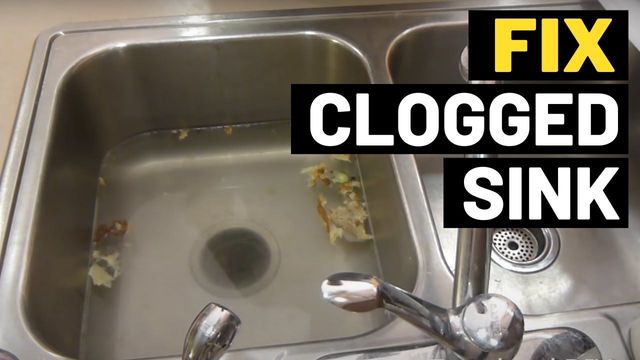Yes, you can use Drano in a kitchen sink, but it’s generally not recommended. While Drano is designed to dissolve clogs, it poses several risks to your plumbing and overall health. There are often safer and more effective alternatives. Let’s delve into the details.

Image Source: lirp.cdn-website.com
The Appeal of Drano for Clogged Kitchen Sinks
A clogged kitchen sink can be a major headache. Food scraps, grease, and other debris can accumulate, leading to slow drainage or a complete blockage. Drano, a readily available chemical drain cleaner, promises a quick and easy solution, making it a tempting choice for many homeowners. The product’s marketing emphasizes its ability to dissolve tough clogs, saving you the hassle and expense of calling a plumber.
How Drano Works
Drano contains a combination of chemicals, including sodium hydroxide (lye) and sodium hypochlorite (bleach). These chemicals react to generate heat and break down organic materials like hair, grease, and food particles. The heat helps to melt away fats, while the caustic chemicals dissolve other debris. The process is designed to clear the blockage and restore proper drainage.
The Risks of Using Drano in Your Kitchen Sink
While Drano may seem like a convenient solution, it comes with several potential downsides:
Damage to Your Pipes
Drano’s harsh chemicals can corrode and damage your kitchen sink pipes, particularly if they are older or made of materials like PVC or certain types of metal. The heat generated during the chemical reaction can also soften or warp plastic pipes, leading to leaks or even complete pipe failure. Over time, repeated Drano use can significantly shorten the lifespan of your plumbing system. Using Drano kitchen sink pipes are not always the best match.
Health Hazards
Drano is highly corrosive and can cause severe burns if it comes into contact with your skin or eyes. The fumes released during the chemical reaction are also irritating to the respiratory system and can be especially harmful to individuals with asthma or other breathing problems. Accidental ingestion of Drano can be fatal. Always handle Drano with extreme caution, wearing gloves and eye protection, and ensuring adequate ventilation.
Ineffectiveness on Certain Clogs
Drano is not a universal solution for all types of clogs. It may be ineffective on blockages caused by solid objects, such as toys, utensils, or large food scraps. In these cases, the chemicals may simply sit on top of the blockage without dissolving it, potentially exacerbating the problem. Drano for grease in kitchen sink might work sometimes, but not always.
Environmental Impact
The chemicals in Drano are harmful to the environment. When flushed down the drain, they can contaminate water sources and harm aquatic life. Wastewater treatment plants may not be able to completely remove these chemicals, leading to their accumulation in the environment.
Interaction with Other Chemicals
Mixing Drano with other cleaning products, especially those containing ammonia, can create toxic fumes. This can lead to serious respiratory problems and even death. Never mix Drano with other chemicals, and always rinse your sink thoroughly after using Drano to remove any residual product.
Drano and Garbage Disposal
Using Drano with a garbage disposal can be problematic. The chemicals can damage the disposal’s blades and other components, leading to malfunctions or failure. Furthermore, the chemical reaction can create a buildup of pressure within the disposal, potentially causing it to explode. It is generally advised to avoid using Drano and garbage disposal together.
Safer Alternatives to Drano for Clearing Blocked Kitchen Sink
Fortunately, several safer and more effective alternatives to Drano exist for clearing a blocked kitchen sink:
Boiling Water
For minor clogs caused by grease or soap buildup, pouring boiling water down the drain can often do the trick. The hot water helps to melt away the grease and flush away the debris.
How to use boiling water:
- Boil a large pot of water.
- Carefully pour the boiling water down the drain.
- Wait a few minutes and then run the tap to see if the drain is clear.
- Repeat if necessary.
Baking Soda and Vinegar
A mixture of baking soda and vinegar can create a fizzing action that helps to dislodge clogs. This method is gentler on your pipes than Drano and is also environmentally friendly.
How to use baking soda and vinegar:
- Pour one cup of baking soda down the drain.
- Follow with one cup of vinegar.
- Let the mixture fizz for 30 minutes.
- Flush with hot water.
Plunger
A plunger is a simple but effective tool for clearing many types of clogs. The suction created by the plunger can help to dislodge the blockage and restore proper drainage.
How to use a plunger:
- Make sure there is enough water in the sink to cover the cup of the plunger.
- Place the plunger over the drain opening, creating a tight seal.
- Push and pull the plunger up and down vigorously for several minutes.
- Remove the plunger and see if the drain is clear.
- Repeat if necessary.
Plumbing Snake (Drain Auger)
A plumbing snake, also known as a drain auger, is a flexible tool that can be inserted into the drain to break up or remove clogs. This is a more effective option for stubborn blockages that cannot be cleared with boiling water, baking soda and vinegar, or a plunger.
How to use a plumbing snake:
- Insert the end of the plumbing snake into the drain opening.
- Rotate the handle to feed the snake further into the drain.
- When you encounter a clog, continue rotating the handle to break up or grab the blockage.
- Pull the snake out of the drain, removing the debris.
- Flush the drain with water to ensure it is clear.
Enzyme-Based Drain Cleaners
Enzyme-based drain cleaners use natural enzymes to break down organic materials. These cleaners are gentler on your pipes and the environment than chemical drain cleaners like Drano. However, they may not be as effective on severe clogs. The alternative to Drano kitchen sink is more eco-friendly.
How to use enzyme-based drain cleaners:
- Follow the instructions on the product label.
- Typically, you will need to pour the cleaner down the drain and let it sit overnight.
- Flush with water in the morning.
Disassembling the P-Trap
The P-trap is the curved section of pipe under your sink. It is designed to trap debris and prevent sewer gases from entering your home. Sometimes, clogs can accumulate in the P-trap. Disassembling and cleaning the P-trap can be a simple solution to clearing the blockage.
How to disassemble and clean the P-trap:
- Place a bucket under the P-trap to catch any water or debris.
- Loosen the slip nuts that connect the P-trap to the drain pipes.
- Carefully remove the P-trap.
- Clean out any debris that is trapped in the P-trap.
- Reassemble the P-trap and tighten the slip nuts.
- Run water down the drain to check for leaks.
Preventing Kitchen Sink Clogs
Prevention is always better than cure. By taking a few simple precautions, you can minimize the risk of kitchen sink clogs:
- Avoid pouring grease down the drain. Grease solidifies as it cools, causing blockages. Instead, pour grease into a container and dispose of it in the trash.
- Use a sink strainer. A sink strainer will catch food scraps and other debris, preventing them from entering the drain.
- Flush the drain with hot water regularly. Hot water helps to melt away grease and prevent buildup.
- Avoid disposing of coffee grounds down the drain. Coffee grounds can accumulate and cause clogs.
- Run the garbage disposal with plenty of water. This helps to flush the debris down the drain and prevent buildup.
Seeking Professional Help
If you have tried all of the above methods and your kitchen sink is still clogged, it may be time to call a professional plumber. A plumber has the tools and expertise to diagnose and resolve more complex plumbing problems. They can also assess your pipes for damage and recommend appropriate repairs or replacements. Don’t hesitate to contact a plumber if you suspect a serious plumbing issue.
Table: Comparison of Drain Cleaning Methods
| Method | Effectiveness | Safety | Environmental Impact | Cost |
|---|---|---|---|---|
| Drano | High (for some clogs) | Low | High | Low |
| Boiling Water | Low to Medium | High | Low | Very Low |
| Baking Soda and Vinegar | Medium | High | Low | Very Low |
| Plunger | Medium | High | Low | Low |
| Plumbing Snake | High | Medium | Low | Medium |
| Enzyme-Based Drain Cleaner | Medium | High | Low | Medium |
| Disassembling P-Trap | Medium | Medium | Low | Very Low |
| Professional Plumber | High | High | Varies | High |
Fathoming the Chemistry Behind Drano
Drano’s effectiveness comes from its powerful chemical reactions. Sodium hydroxide, a strong base, reacts with grease and fats through a process called saponification, turning them into soap-like substances that are more easily dissolved in water. Sodium hypochlorite, or bleach, acts as an oxidizer, breaking down organic matter and further aiding in the dissolving process. The combination of these reactions generates heat, which helps to melt away stubborn clogs. However, this intense chemical activity is what makes Drano so risky for your pipes and your health.
Drano Kitchen Sink Safe? Weighing the Pros and Cons
The question of whether Drano is safe for your kitchen sink is complex. While it may effectively clear some clogs, the potential damage to your pipes, health hazards, and environmental impact make it a risky choice. Safer alternatives, such as boiling water, baking soda and vinegar, a plunger, or a plumbing snake, are often just as effective and far less harmful. When considering whether to use Drano kitchen sink safe options should be explored first.
FAQ About Drano and Kitchen Sinks
Q: Can Drano damage my kitchen sink pipes?
A: Yes, Drano’s harsh chemicals can corrode and damage pipes, especially older or plastic ones.
Q: Is Drano safe to use with a garbage disposal?
A: No, Drano can damage the garbage disposal’s components and potentially cause it to explode.
Q: What should I do if Drano splashes on my skin?
A: Immediately rinse the affected area with plenty of water for at least 15 minutes and seek medical attention.
Q: Can I mix Drano with other cleaning products?
A: No, mixing Drano with other chemicals can create toxic fumes.
Q: What is the best way to prevent kitchen sink clogs?
A: Avoid pouring grease down the drain, use a sink strainer, and flush the drain with hot water regularly.
Q: When should I call a plumber for a clogged kitchen sink?
A: If you have tried all of the safer methods and the sink is still clogged, or if you suspect a serious plumbing issue.
Q: Are there eco-friendly alternatives to Drano?
A: Yes, baking soda and vinegar and enzyme-based drain cleaners are environmentally friendly options.

Hi, I’m Larry Fish, the mind behind MyGrinderGuide.com.. With a passion for all things kitchen appliances, I created this blog to share my hands-on experience and expert knowledge. Whether it’s helping you choose the right tools for your culinary adventures or offering tips to make your kitchen more efficient, I’m here to guide you. My goal is to make your time in the kitchen not only easier but also enjoyable! Welcome to my world of kitchen mastery!
